ADATA XPG V1.0 Low Voltage Review: 2x8 GB at DDR3L-1600 9-11-9 1.35 V
by Ian Cutress on December 6, 2013 2:00 PM ESTIGP Compute
One of the touted benefits of Haswell is the compute capability afforded by the IGP. For anyone using DirectCompute or C++ AMP, the compute units of the HD 4600 can be exploited as easily as any discrete GPU, although efficiency might come into question. Shown in some of the benchmarks below, it is faster for some of our computational software to run on the IGP than the CPU (particularly the highly multithreaded scenarios).
Grid Solvers - Explicit Finite Difference on IGP
As before, we test both 2D and 3D explicit finite difference simulations with 2n nodes in each dimension, using OpenMP as the threading operator in single precision. The grid is isotropic and the boundary conditions are sinks. We iterate through a series of grid sizes, and results are shown in terms of ‘million nodes per second’ where the peak value is given in the results – higher is better.
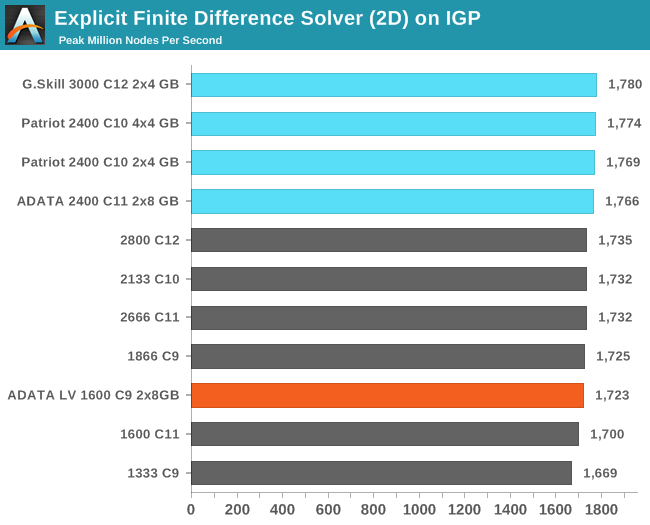
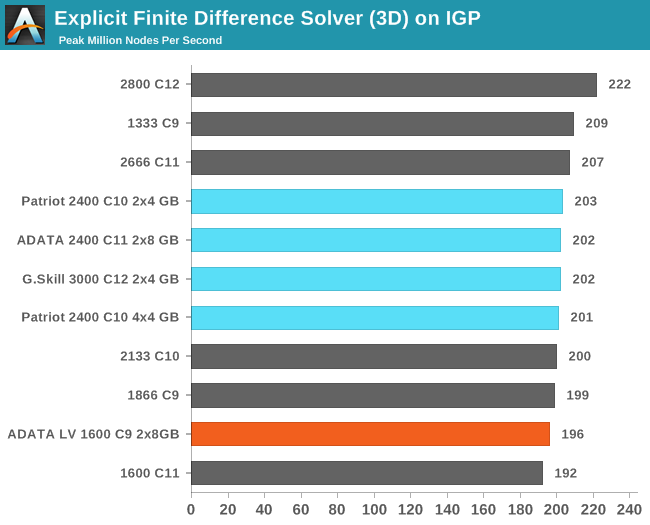
On our IGP compute the 1600 C9 LV takes a bit of a knock in both 2D and 3D simulations when compared to the more powerful kits available - by as much as 10% in 3D.
N-Body Simulation on IGP
As with the CPU compute, we run a simulation of 10240 particles of equal mass - the output for this code is in terms of GFLOPs, and the result recorded was the peak GFLOPs value.
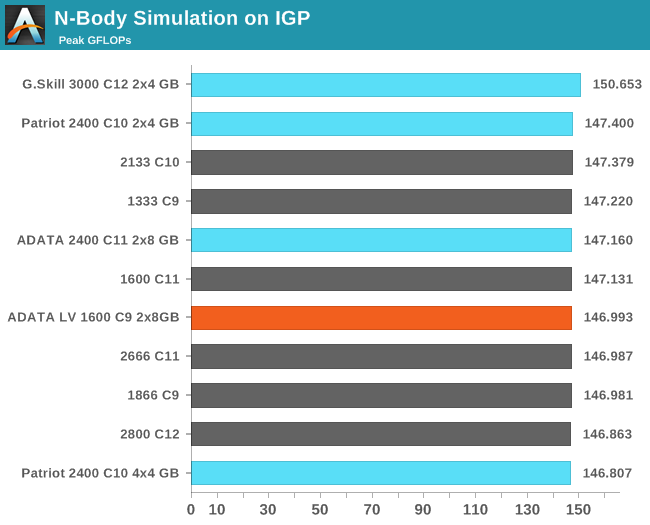
3D Particle Movement on IGP
Similar to our CPU Compute algorithm, we calculate the random motion in 3D of free particles involving random number generation and trigonometric functions. For this application we take the fastest true-3D motion algorithm and test a variety of particle densities to find the peak movement speed. Results are given in ‘million particle movements calculated per second’, and a higher number is better.
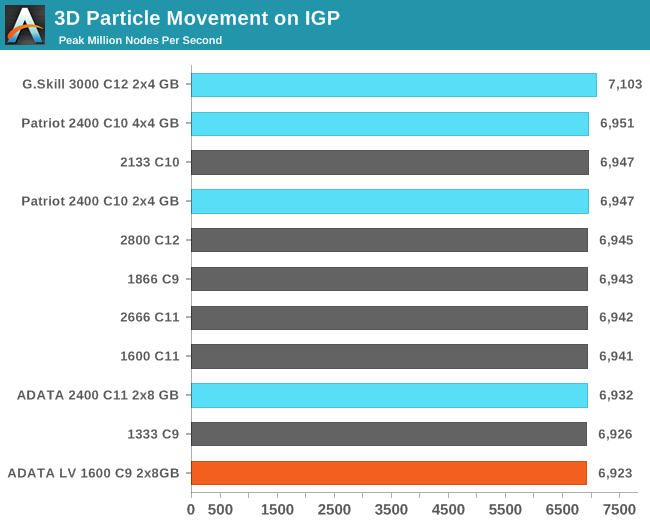
Matrix Multiplication on IGP
Matrix Multiplication occurs in a number of mathematical models, and is typically designed to avoid memory accesses where possible and optimize for a number of reads and writes depending on the registers available to each thread or batch of dispatched threads. He we have a crude MatMul implementation, and iterate through a variety of matrix sizes to find the peak speed. Results are given in terms of ‘million nodes per second’ and a higher number is better.
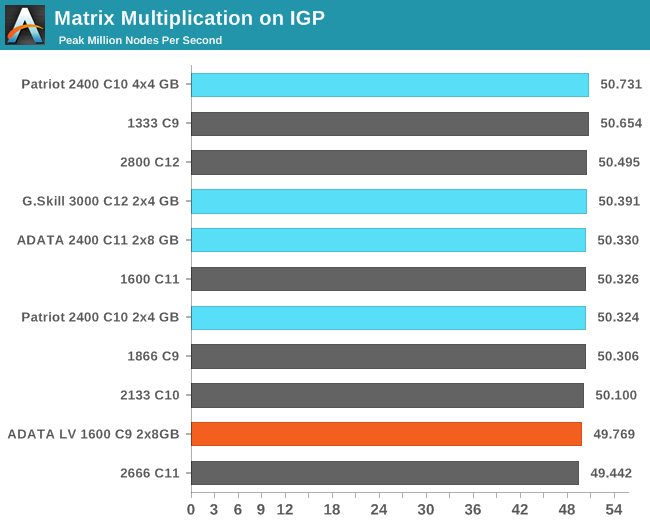










35 Comments
View All Comments
MelvisLives - Friday, December 6, 2013 - link
even for things like folding the T/S series make little senseI run my normal 84W haswell i5 at 2.6Ghz with a -0.26V offset to allow me to run it in my htpc case without a cpu fan, maths says its max tdp will be about 40W, with the added bonus I can increase it if i want or move case.
so i guess my point is, T series cant be made to hit the same levels as a standard i5 but a standard i5 will undervolt/underclock to T series level, and they cost exactly the same, making T series poor value.
popej - Friday, December 6, 2013 - link
I have recently flashed BIOS update, which included new microcode from Intel. As I understand this microcode update not only disabled any overclock for non-K Haswell (multicore enhancement) but also possibility to undervolt CPU. It is quite possible, that your i5 could be affected too.MelvisLives - Saturday, December 7, 2013 - link
thats sad to hear if its true, and does change things slightly, but it also means that intel are aware how poor value the T/S chips are and are trying to keep a market for them since a i5-4570 is the same price as an i5-4570S and 4570T.peterfares - Sunday, December 8, 2013 - link
But that raises the question: why bother? If they're the same chips sold at the same price, why artificially make three different models with different capabilities? It makes sense if they sell them for different prices (even if it is a douchy thing to do).ShieTar - Tuesday, December 10, 2013 - link
The non-T/S versions are usually better/more efficient than specified, so in most cases they will indeed perform the same as the T/S. But you could be unlucky and get a unusually inefficient normal chip, which really uses up its 84W TDP.purerice - Friday, December 6, 2013 - link
Thank you for your explanation. I actually had been tempted by the 4770S/4670T because I thought there was a bigger difference. I am still in the age where underclocking was done manually.As for this RAM, the article was very in depth and well-done but I am a little disappointed that the article didn't show any make or break situations. For example, all of the dGPU framerates were playable while none of the iGPU framerates were playable. The tests should have been done at resolutions that would have produced borderline playability to better see in which situations the there would be a noticeable difference.
MrSpadge - Sunday, December 8, 2013 - link
Agreed: regular CPUs with lowered voltage are far better value than S/T models. Or underclocked and undervolted, if necessary. This does involve manual testing, though.oranos - Friday, December 6, 2013 - link
what's the point of "low voltage" ram. I fail to see any real world difference between 1.35v and 1.5v standard.MrSpadge - Sunday, December 8, 2013 - link
You've got to run a lot of them, like in a server farm, for this to matter.shing3232 - Friday, December 6, 2013 - link
I would like to have this kind of ram at laptop